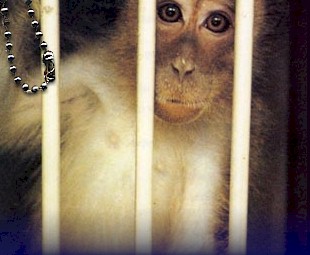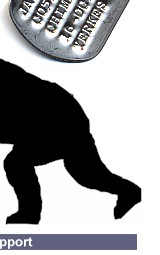#25142
CRAB EATING MACAQUE
A
female crab-eating macaque was received into quarantine at the California
Regional Primate Research Center (CRPRC) in Davis, California on
September 6, 1989. She never left.
She
weighed 2.6 kilograms a week after she arrived. No document is included
in her records regarding her previous location. Perhaps she had
been captured from the jungles of Southeast Asia. CRPRC estimated
she was seven years old.
On September 12, she was tattooed with the serial number 25142.
Just like the Nazi’s tattooed the Jews they captured.
According
to CRPRC records, 25142 was immobilized with Ketamine at least
seventy-eight times during the nearly ten years she spent at CRPRC
and had blood drawn on at least 100 different occasions. She was
moved to a new location on at least thirteen occasions.
Macaques are well known for the complex social groups in which they
live. Matriarchal hierarchies determine status within the groups,
which can member up to approximately sixty monkeys of mixed ages.
Females typically remain in the group in which they are born throughout
their lives. Individual animals are keenly aware of the alliances
between the matrilineages and the family to which each group member
belongs. For female macaques, their lives are ones of stability
and social complexity. Removing one of these animals from her group
must be viewed as the paramount insult to their psychological well-being.
Placing such individuals in cages with no companionship, with no
opportunity for foraging or exploration, with a very limited amount
of space, is a well-known cause of neurosis that often develops
into a full-blown psychotic condition replete with self-mutilation
and stereotypic behaviors. The mental stress associated with the
experiences of typical laboratory usage cannot be overstated.
25142’s decade-long experience at CRPRC was recorded in thirty-nine
pages of hand-written observations and notations. The entries are
often cryptic, occasionally illegible, and generally business-like.
These thirty-nine pages are supported with another forty-two pages
of lab reports and a thirteen-page document describing, in a general
way, the experiment that led to her death.
This is the story of one monkey’s victimization by us.
25142 was released from quarantine on December 7, 1989 after being
x-rayed and having a sonogram to evaluate her reproductive status.
Her record is sparse up until April 17, 1991, at which time a notation
was made that her abdomen was distended. The note says that she
was having a late pregnancy (162 days), but that the abdominal swelling
might be due to bloat. Counting back, she must have been impregnated,
probably artificially, on October 7, though no mention of this occurs
in her records.
On the 19th someone wrote: “Animal has normal stools and doesn’t
appear uncomfortable therefore bloat unlikely. Maximum gestation
170 D. in cynos. Expect parturition by early next week, if baby
not born by Wed. consider C-section.”
Laboratory personnel refer to crab-eating macaques as cynomolgus
monkeys. Their scientific name is Macaca fascicularis.
April 22: “Preg 167 D. Stools normal, animal appears happy,
healthy. Will ultra-sound at day 169 if parturition hasn’t
occurred by then.”
Primate-using scientists write frequently that attending to the
psychological well-being of monkeys and apes is a subjective effort
at best. Ronald Hunt, a past director of the New England Regional
Primate Research Center at Harvard University, summed up the researchers’
position nicely when he wrote, “The mental health of monkeys
is unknown.” [Hunt, R. 1991. “The Necessity for Interpretation
of Standards Designed to promote the Psychological Well-Being of
Non Human Primates.” In Through the Looking Glass: Issues of
Psychological Well-Being in Captive Non-Human Primates. M.A. Novak
and A. J. Petto, eds. Washington D.C. 1991. American Psychological
Association.]
The fact that observant people are able to make meaningful, if subjective,
observations concerning monkeys’ mental health such as whether
an animal appears generally “happy” or “depressed”
seems to be lost on the defenders of their use in biomedical research.
April 23: “Informed by tech – mother having dys[unclear]
– Infant’s head and shoulders still inside. Gave .4 [unclear]
ketamine to immobilize. While going d[unclear], presented infant
but no placenta extracted placenta – infant dead. 1 ml oxytocin.”
[oxymorphone]
No follow-up entry occurs.
From April 23, 1991 to April 9, 1992, only eleven entries were made.
Seven of these are weights; she went from 3.87 kilograms to 3.47
kilograms.
Beginning on the 9th, a series of cryptic daily entries
were made. The first says: “Handheld for [unclear] (+).”
For the next seventeen days, the entries, “DRB 50: 8.7 ml (1mg/ml)
NGT,” “Handheld for [unclear] (+),” and “Bled
[1 to 8] cc…DRB 50,” are interwoven from day to day. It
seems likely that 25142 was being used in some experimental manner.
Monkeys are not domesticated companion animals. Dogs and cats have
been bred over time to accept, even enjoy, being held or hugged.
To a monkey, being handheld while someone else does something to
you must be quite stressful and, likely, frightening.
On the 26th, a notation was made that she has had a “Pre-hysterotomy
exam.” Also on this day she underwent a surgical procedure
termed “Embyotomy.” The details are very sparse, and the
surgical report is essentially little more than a cryptic note:
“Ventral midline abdominal incision. Exteriorize uterus. Uterotomy
incision central fundal longitudinal. Dissect out embryo membrane
intact.” The remaining few words list the type of suture material
used to sew up all the wounds.
Websters Dictionary defines “embryotomy” as: “The
cutting a fetus into pieces within the womb, so as to effect its
removal.”
On the April 29, a comment was made suggesting she was starting
a new menses.
Not much is reported over the ensuing year. Comments occur occasionally
regarding her menses. Apparently she was being used to produce fetuses
on which some experimental substance was tested.
On January 29, she was reported to be bleeding. It was suggested
that this might have been “late gestational bleeding”
or, maybe, not obstetric at all.
On February 4 she was treated for dehydration and was described
as depressed. She was active after the treatment.
On March 23, and April 12, 1993 samples of her fetus were taken.
On April 22, a Cesarean section was performed and the baby was reportedly
delivered alive.
No mention of her baby appears again in her records.
Injections resumed on July 28, 1993. On the 29th she
was reported to be vomiting and the suggestion was made that this
might have been an effect of the Ketamine. No mention was made of
the experimental substance she was injected with the day before.
On January 12, 1994 she was reported to have a wound on the tip
of the second finger of her right hand. It was characterized as
superficial and left untreated.
Injections and blood draws continued. At some point she must have
been again impregnated. November 19, 1994: “[unclear] no blood
seen. Liq[uid] stool could be very thick vomit. Day 125 pregnancy.”
On November 28, she had another cesarean. This time the baby was
dead.
On the 29th there was blood and vomit under the cage
she was in.
On January 18, 1995, she had a reproductive evaluation. It was noted
that she had adhesions.
Injections and blood draw resumed. On July 26, she was seen for
another injury to her right hand. The wound was deemed superficial
and cleaned. An accompanying note: “trauma to finger superficial
and probably occurred during cage pull.” She must be fighting
the repeated injections, blood draws and examinations.
On December 17, she was again seen for another wound, this time
to her left hand. Once again, it was judged superficial and left
alone.
On January 26, 1996, she was reported to be pregnant again. On the
30th she was vomiting and was reported to be losing weight.
Beginning on February 21, blood was taken daily through the 29th.
On the 29th it was noted that her feces was dry, that
she was thin, and had been experiencing progressive weight loss.
March 10, 1996: “Reported thin & dehydrated. Animal has
lots of skin folds on abdomen and face. But skin turgor is good.
Gradual weight loss over past six months.”
On March 11, she was evaluated for her weight loss. A fecal sample
was sent to the lab. She was described as thin but otherwise “normal.”
It was suggested that they offer her more food.
On the 12th, there were many uneaten monkey biscuits
in the cage and vomit underneath.
On the 14th, the lab results were back and the suggestion
was made that 25142 might have liver disease.
On March 22, she underwent a blood sugar test related to the suggestion
of liver disease. Following the test, during which she was anesthetized,
she was reported to be weak.
The blood draws and examinations continued.
On the 26th and 27th there was blood under
the cage. It was suggested that this was normal menses.
On April 4, someone confirmed that she was thin and suggested they
give her more food.
On April 25, someone suggested that her thinness might have been
due to the fact that she had been receiving daily ultra sound examinations.
These, of course, were conducted while she was immobilized with
Ketamine.
On May 7, she was again noted to be thin and again it was suggested
that she be given additional food.
The daily ultrasounds and blood draws resumed on the 17th
and continued through May 27.
On the 31st, she was reported to have mucus in her stool.
June 30: “Rept depression – animal looks active and normal
to me.”
July 14: The blood draws and ultra sound examinations resumed and
continued through the 24th.
On July 31, 1996, 25142 had blood drawn in preparation for a new
experimental project. This one was coded PPV04.
On August 8, she was reported to be vomiting. On August 30 she was
said to be thin. On November 15, 1996, 25142 received an intranasal
and an intrarectal inoculation of human polio vaccine as a part
of the new study.
On August 18, and 22, the inoculations, both intra-nasal and intra-rectal
were repeated.
On December 10, it was recorded that she continued to have a poor
appetite and had loss a little more weight. Earlier, in 1994 she
had weighed 5 kilograms. Now she was down to 3.5 kilos. A suggestion
was made that she be offered fruit every day
On December 14, she was reported to have liquid bloody stool and
to have a poor appetite. Mention was made that she had hepatobiliary
disease and that this was leading to her chronic anorexia.
December 19: “anorexia persists to some extent but stool is
normal – PI [the Principal Investigator, the scientist using
her in their experiments] refused further work up for liver disease.
Progressive liver disease of unknown etiology – condition stable.
Supportive care.”
Blood continued to be drawn.
December 27: “P.I. decided that further work-up is merited.”
December 29: “Rept. No stool. Animal has scant stool under
cage. Not eating much.
She started receiving dietary supplements and seemed to pick up
a bit.
January 10, 1997: “Recent weight loss likely due to 2 days
of fasting and anesthesia. Continue to offer supplements and monitor
closely.”
January 14: “Animal’s appetite has improved.”
On January 22, lab work was considered supportive of the possibility
of liver disease.
Blood continued to be drawn periodically.
On February 21, someone suggested she be given calorie-rich dietary
supplements.
On March 10 she was again intranasally inoculated with Sabin polio
vaccine; and again on the 12th and 14th.
Blood continued to be taken.
March 23: “Re no stool & depression. Noted decreased appetite.
Though lots of normal stool animal is a little quiet but moving
around the cage well. Stable. Monitor.”
On May 31 she was reported to be vomiting and experiencing a heavy
menses.
June 14: She was reported to be vomiting again, but this was considered
a side effect of the Ketamine she was given the day before.
On June 25 she was reported to be depressed; the person responding
to the report noted that although she was quiet, she would react
and move around the cage.
July 16: “Reported for depression. Animal vocalized, stood,
made aggressive posturing movements, and moved freely about the
cage. Behavior [within normal limits] Continue to monitor.”
July 17: “Animal reported for depression and poor appetite.
Seen 3 left over cookies. Not depressed. Continue to monitor.”
August 18: “Reported for depression. Appeared somewhat depressed
also noted normal menses. Monitor.
Blood continued to be drawn periodically.
Reports of depression and poor appetite continued to be discounted.
On February 10, 1998 she was tattooed again.
Entries continued to suggest some lab work should be done for the
possibility of liver disease.
On October 14, the area around her tattoo was shaved.
Her appetite remained poor.
March 10, 1999: “Re depression. Unable to confirm. Animal very
reactive. Aggressive.”
California Primate Research Center
Pathology: Necropsy Report
Animal I.D: MCY25124
Room-Cage AB 5007-80
Investigator: [Hidden by CRPRC]
Pathologist: [Hidden by CRPRC]
Body Weight After Death: 4.06 kg
Sex: F
Age: 16y 6m
Project Code: PVV06
Clinician: [Hidden by CRPRC]
Death Date: 3-18-99
Type of Death: Exp. Death
Date of Necropsy: 3-18-99
Clinical History: Moved to infectious housing on 8/7/96.
Intranasal and rectal inoculation with human polio vaccine on 11/15/96,
11/18/96, 11/22/96, and 11/25/96. Intranasal inoculation with 4x10e7
pfu Sabin polio vaccine on 3/7/97. 3/10/97, 3/14/97. Experimental
cull on 3/18/99.
Clinical Diagnosis: Open.
Gross Observations: Body as a whole: The animal is
presented in good flesh.
Gross & final Diagnosis: 1. Polio.
////////////////////////////////////////2.
Tissue harvest.
////////////////////////////////////////3.
NSL.
Comments: Tissues are harvested for the investigator. No
tissues are saved for CRPRC histopathology.
The study that 25142 was being used for was named Development of
Recombinant Polyvalent Viral Vaccines.
In this study, monkeys were inoculated with the Sabin polio vaccine
that had been made with a poliovirus, just like the original polio
vaccine. But this poliovirus had SIV, or simian immunovirus genes
inserted into it. SIV is a virus that can kill some species of monkeys.
The researchers noted in their proposal that “No human disease
related to SIV has ever been described.” (p 13)
In the protocol, the researchers characterized the pain associated
with the experiment as: “Severe pain near, at or above the
pain tolerance threshold.” (p 5) Elsewhere, they said, “no
pain or discomfort is anticipated for the animals.” (p 6)
The monkeys used were subjected to lymph note and colon biopsies.
Plans had been made to infect some with SIV to see whether the vaccine
had an effect. Since no mention was made of SIV in the necropsy
report, we assume 25142 was never infected with the virus. Thus,
the results of her repeated nasal and rectal immunizations were
never tested.
It should be obvious that 25142 was ill on August 8, 1996 when she
began receiving the inoculations. Whether her poor health was a
function of the previous experiment she was engaged in is subject
to speculation. From the records, CRPRC never considered this possibility,
but we cannot say with certainty whether they did or not.
What can be said with absolute certainty is that a very unhealthy
animal was chosen to experiment on. A very unhealthy animal was
selected for use in an experiment on the immune system. It is likely
that a junior high school student, just beginning to learn the scientific
method, would see the flaw in this situation.
The life story of 25142 is one of isolated misery. It is an ethical
disaster. Not only is the fact that she was used at all unethical,
but also, and compounding, is the fact that she was used in this
pseudoscientific and transparently flawed protocol.
Like all primate labs across the country, CRPRC has been blinded
to the facts by its own defensive effort to protect itself from
public criticism. One need only contrast the reality of 25142’s
decade at the center with the public picture CRPRC chooses to present:
http://www.crprc.ucdavis.edu/crprc/CRPRC-Gallery%20frameset.html
25142, may you rest in peace.
Note: A special thanks to Jenny Gifford from Centerburg, Ohio, for
taking the time to write to CRPRC and ask about 25142. One day,
as other voices join with her's, all the labs will be closed forever.
Home Page | Our Mission | News
What Are Primate Freedom
Tags | Order Tag
Primate Research
Centers | Resources
|






